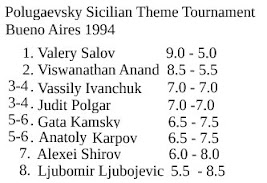The 1994 Sicilian Theme tournament in Buenos Aires was arranged to celebrate Lev Polugaevsky's 60th birthday and Polugayevsky himself was supposed to participate.
Polugayevsky (November 20, 1934 - August 30, 1995) was one of the strongest players in the world from the early 1960s until the late 1980s.
At the time of the tournament, having undergone surgery, he was too ill to participate and he died of a brain tumor on August 30, 1995.
Over the board thematic tournaments have been rare although in the early part of the 20th century some thematic tournaments that featured gambits were played.
In the following game Polgar unleashed an opening novelty and followed it up with some spectacular fireworks. Polgar spent only 48 minutes on the game and she won the prize for the most important opening innovation.
The game also demonstrates an important tactical motif...when two Ns are hanging around an exposed K always look for a mate!
[Event "Sicilian Theme Tmt, Buenos Aires"]
[Site ""]
[Date "1994.??.??"]
[Round "?"]
[White "Alexey Shirov"]
[Black "Judit Polgar"]
[Result "0-1"]
[ECO "B45"]
[Annotator "Stockfish 15.1"]
[PlyCount "58"]
[EventDate "1994.??.??"]
{Sicilian Defense} 1. e4 c5 2. Nf3 e6 3. d4 cxd4 4. Nxd4 Nc6 {This is
characteristic of the Taimanov Variation. Black intends to play in the center,
but the move is also quite flexible.} 5. Nc3 {Avoiding the Maroczy Bind (5.c4)
which is a horse of an entirely different color.} d6 {Played with the
intention of reaching the Scheveningen Variation. It's a Taimanov after 5...Qc7
} 6. g4 {This is not the Keres Attack because black does not have a N on f6.
The text move gained notoriety when Kasparov played it against Karpov in their
1985 World Championship match. Black's problem is finding a move that's better
6...Nf6} a6 {A high class waiting move. Black can now safely play ...Qc7
without worrying about being attacked by Nb5 and later playing ...b5 and ...Bb7
} 7. Be3 Nge7 8. Nb3 b5 9. f4 {For some time after this game 9.Qe2 was
considered better, but now this move is back in style.} Bb7 10. Qf3 {While
technically this may not be bad, practically speaking Po;gar's reply puts
white in a difficult position.} (10. Qd2 {as in Sivuk,V (2552)-Tosic,M (2360)
Chelyabinsk RUS 2019 is white's best move.} Nc8 {Better was 10...Na5} 11. O-O-O
Be7 12. Qf2 Qc7 13. Bg2 Na5 14. Nxa5 Qxa5 15. e5 {with the advantage.}) 10...
g5 {This dangerous looking move is aimed at attacking the dark squares and by
offering a P black gets a good square for her N on e5.} (10... Na5 {shows what
happens if black ignores what white is planning on the K-side.} 11. O-O-O Nxb3+
12. axb3 Rc8 13. h4 Nc6 14. g5 Qa5 15. Kb1 Nb4 16. Bd4 d5 17. f5 {and white
stands better although in Shirov,A (2740)-Kasparov,G (2805) Novgorod 1994,
Kasparov manage to get a draw.}) 11. fxg5 Ne5 12. Qg2 {This move is necessary
because the e-Pawn needs defended. If, say, 12.Qg3 then 12...b4 forces the
d-Pawn's defender to retreat.} b4 (12... h5 {This appears to be an equally
good alternative.} 13. gxh5 Nf5 14. Bf2 Qxg5 15. Na5 Qxh5 16. Nxb7 Nf3+ 17. Kd1
N3h4+ 18. Be2 Ne3+ 19. Bxe3 Nxg2 20. Bxh5 Nxe3+ 21. Ke2 Rxh5 22. Kxe3 Rb8 23.
Nxd6+ Bxd6 {and Savchenko,B (2652)-Sharafiev,A (2439) Dagomys RUS 2010 ws
eventually drawn.}) 13. Ne2 h5 {An incredibly interesting move, the idea of
which is to open lines against white's K. Stockfish evaluates this position as
offering equal chances, but it's very complex and obviously the onus of
proving he can survive is on white.} 14. gxh5 {This is the move that gets
white into trouble. The Ps look to be very dangerous, but Polgar's next move
is yet another hyper-aggressive move.} (14. O-O-O {Fleeing to safety!} hxg4 15.
Ng3) 14... Nf5 {Taking advantage of the pin on the e-Pawn, black places the
other N on a strong square.} 15. Bf2 (15. exf5 {This Q sac was somewhat better,
but OTB it's a very difficult decision to make.} Bxg2 16. Bxg2 Rc8 17. fxe6
fxe6 18. Nbd4 {but white does not seem to have quite sufficient compensation.})
15... Qxg5 {Stunning! This move would not have been possible without 13...h5
luring the g-Pawn away. It also shows why white should not have played 13.gxf5}
16. Na5 {About as good as any. It looks like white is managing to habg on, but
Polgar's next move shatters that illusion.} (16. Ng3 {runs into} Nh4 17. Qh3
Nhf3+ 18. Kd1 d5 {White can survive for long.}) (16. Qxg5 Nf3+ 17. Kd1 Nxg5 18.
exf5 Bxh1 {and white's position is lost.}) 16... Ne3 17. Qg3 (17. Qxg5 Nf3#) (
17. Bxe3 Qxe3 18. Nxb7 Nf3+ 19. Qxf3 (19. Kd1 Qd2#) 19... Qxf3) 17... Qxg3 18.
Nxg3 Nxc2+ 19. Kd1 Nxa1 20. Nxb7 {How does black rescue the N stranded on a1?}
b3 (20... Rc8 21. Bxa6 Rc2 22. Bb5+ Ke7 23. Be1 Rxb2 {also would win, but 20...
b3 is simpler.}) 21. axb3 (21. a3 Nc2) 21... Nxb3 22. Kc2 Nc5 23. Nxc5 dxc5 {
Black has a routine win.} 24. Be1 Nf3 25. Bc3 Nd4+ 26. Kd3 Bd6 27. Bg2 Be5 28.
Kc4 Ke7 29. Ra1 Nc6 {White resigned.} 0-1



No comments:
Post a Comment